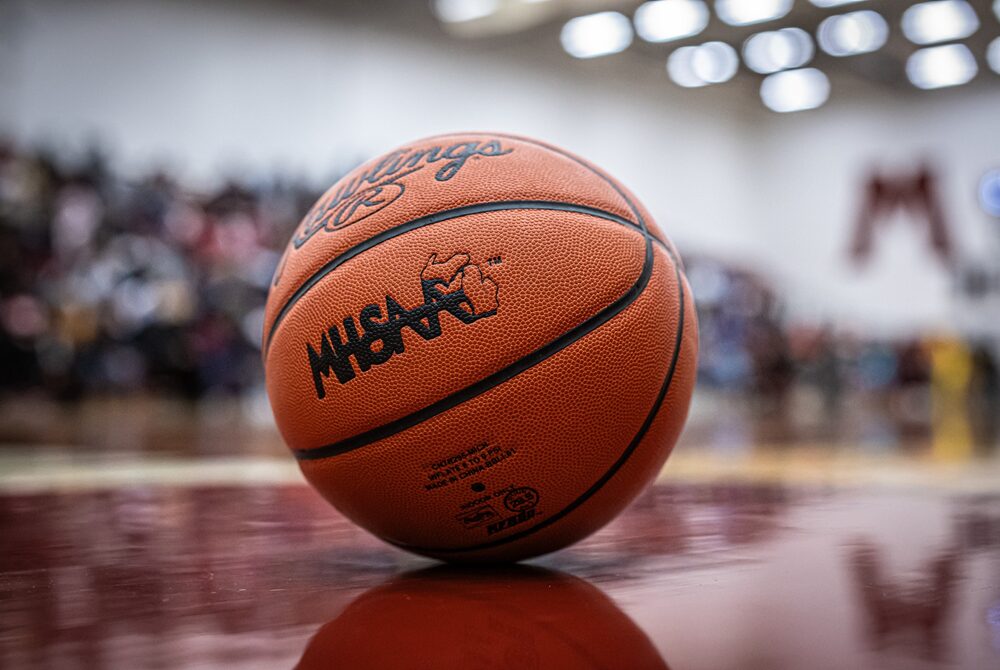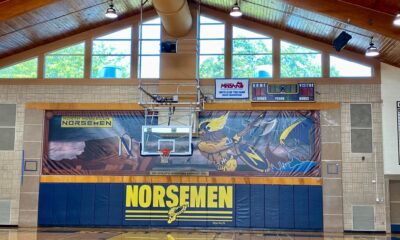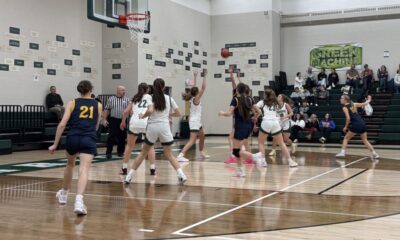
Basketball might look the same at every level, but the rules change as players move from high school to college and professional play. In Michigan, the Michigan High School Athletic Association (MHSAA) follows the National Federation of State High School Associations (NFHS) rule book, setting the foundation for teamwork, discipline, and fair competition across the state.
High School Basketball in Michigan (MHSAA Rules)
High school basketball games in Michigan are played in four eight-minute quarters with a 10-minute halftime. Each player is allowed five personal fouls before disqualification. When a team commits five fouls in a quarter, the opposing team enters the bonus and shoots free throws on every defensive foul for the rest of that period.
The three-point line sits at about 19 feet, 9 inches from the basket—shorter than in college or professional play. Each team is allowed five time-outs per game, and substitutions may occur during any dead ball with an official’s permission.
If one team gains a 40-point lead in the second half, the running clock rule begins and continues until the lead drops below 30 points. During postseason tournaments, schools compete in Divisions 1 through 4 based on enrollment size, and each team may dress up to 15 players.
Unlike college or professional basketball, Michigan high schools do not use a shot clock, allowing teams to focus on patience, execution, and strategy instead of time pressure.
Player Conduct and Game Procedures
Players must wear uniforms that meet MHSAA standards for color, numbering, and safety. Jewelry is not permitted, and technical fouls may be called for unsportsmanlike behavior or improper equipment. Flagrant fouls, such as dangerous or intentional contact, result in immediate ejection.
Coaches must complete annual MHSAA rules meetings, maintain CPR certification, and ensure all players are eligible before each season. Officials enforce NFHS rules, and all disputes follow MHSAA procedures. At lower levels like junior varsity or middle school, some modifications (shorter quarters or smaller basketballs) may be approved locally, but only with MHSAA approval.
Miscellaneous Rules and Details
Beyond the major rules, several smaller ones keep the game balanced and fair. The five-second closely guarded rule prevents a player from holding or dribbling the ball too long while a defender is within six feet. Teams have ten seconds to advance the ball across half court and cannot return to the backcourt after crossing, or they’ll commit a backcourt violation.
When inbounding, the player has five seconds to pass the ball once the official hands it over. On free throws, lane players may enter the lane when the shooter releases the ball, while the shooter must wait until it touches the rim. These details build awareness and timing into every possession, helping young athletes develop smarter habits and clean execution.
Overtime and Jump Ball Rules
If a game ends in a tie, it goes into overtime, lasting four minutes. Each team receives one additional time-out, and fouls from regulation carry over. If the game remains tied, extra periods are played until there’s a winner.
The game begins with a jump ball at center court, but afterward, all held-ball situations use alternating possession, giving each team fair opportunities without repeated jump balls. This keeps the pace smooth and consistent throughout the game.
Common Violations and Court Rules
Common violations shape the rhythm of play. Traveling occurs when a player takes more than two steps without dribbling, while double dribbling happens when a player stops and restarts their dribble. Goaltending and basket interference occur when a player touches the ball as it descends toward the hoop or interferes with the rim while the ball is above it.
Players must understand pivoting and jump stops to avoid traveling calls. Once a player stops dribbling, one foot becomes the pivot and must remain planted. A held ball occurs when both players gain firm control simultaneously, resulting in alternating possession.
An out-of-bounds call occurs when any part of a player or the ball touches the boundary line. Unused time-outs from regulation carry into overtime, and one extra is added per period. These smaller rules help reinforce timing, teamwork, and respect for proper play.
Additional High School Rules to Know
High school basketball also includes several less noticeable but equally important rules. Illegal substitution occurs when more than five players are on the court or when a player enters without official recognition, resulting in a technical foul. A stalling or delay rule allows officials to warn teams that refuse to advance the ball or attempt to score, even without a shot clock.
Bench conduct is carefully monitored — coaches and staff must stay inside the 28-foot coaching box, and leaving it without permission can draw a technical. Equipment and court setup are standardized: baskets are 10 feet high, the free-throw line is 15 feet from the backboard, and the three-point line is 19 feet, 9 inches away. High school courts are typically 84 feet long and 50 feet wide.
Timeout rules state that coaches or players may call a timeout only when their team has possession or during a dead ball, not while the ball is loose or in the air. Technical and flagrant fouls can result from arguing, inappropriate language, or unnecessary contact, with flagrant fouls causing immediate ejection. A delay of game can be called for touching the ball after a made basket, failing to return promptly after a substitution, or otherwise stalling play.
Pregame and uniform procedures are also regulated. Teams must remain on their designated side during warmups, and crossing midcourt before tip-off can result in a warning or technical foul. Uniforms must display legal numbers, have clearly contrasting colors (light for home, dark for visitors), and follow NFHS spacing and size standards.
If a player is injured during a shooting foul, the opposing coach selects a replacement free-throw shooter from those already on the court. Ejected players or coaches must serve a one-game suspension, missing the next scheduled contest. Finally, the mercy rule (running clock) stays active for the remainder of the second half once triggered, stopping only for timeouts, injuries, or official delays.
Together, these rules ensure every Michigan high school basketball game is played with structure, safety, and sportsmanship in mind — the exact values that the MHSAA strives to protect.
How College and Pro Rules Differ
At higher levels, the game becomes faster and more specialized. College teams use a 30-second shot clock, while the NBA and WNBA use 24 seconds, emphasizing quick decision-making and faster possessions. College men’s games have two 20-minute halves, while women’s games use four 10-minute quarters, matching professional timing.
Professional players can commit six personal fouls, and the three-point line extends to 22–23 feet, 9 inches. Pro leagues also use a defensive three-second rule, which stops players from camping under the basket — something not seen in high school or college play.
Why These Differences Matter
MHSAA basketball emphasizes discipline, teamwork, and patience. Without a shot clock or professional pace, athletes learn to value spacing, communication, and control. These lessons prepare players for faster and more advanced competition later in their careers.
Whether on a small-town high school court or in a professional arena, basketball’s foundation stays the same — respect for the game, focus on fundamentals, and a love of competition. The rules may differ, but the heart of basketball never changes.


Must See
-


Basketball
/ 8 hours agoNorth Muskegon’s Gym: The “Old Barn,” a Campus Cornerstone, and a Home for History
Walk into North Muskegon High School on game night and you can feel it...
By Kara Raeth -


Basketball
/ 12 hours agoGirls Basketball Roundup — Season Openers
Opening week of girls basketball delivered a little bit of everything — fast starts,...
By Kara Raeth -


Basketball
/ 1 day agoFruitport Boys Basketball Brings the Energy to CatchMark for Media Day
Fruitport Varsity Boys Basketball stopped by CatchMark for a team media day, and it...
By Kara Raeth









